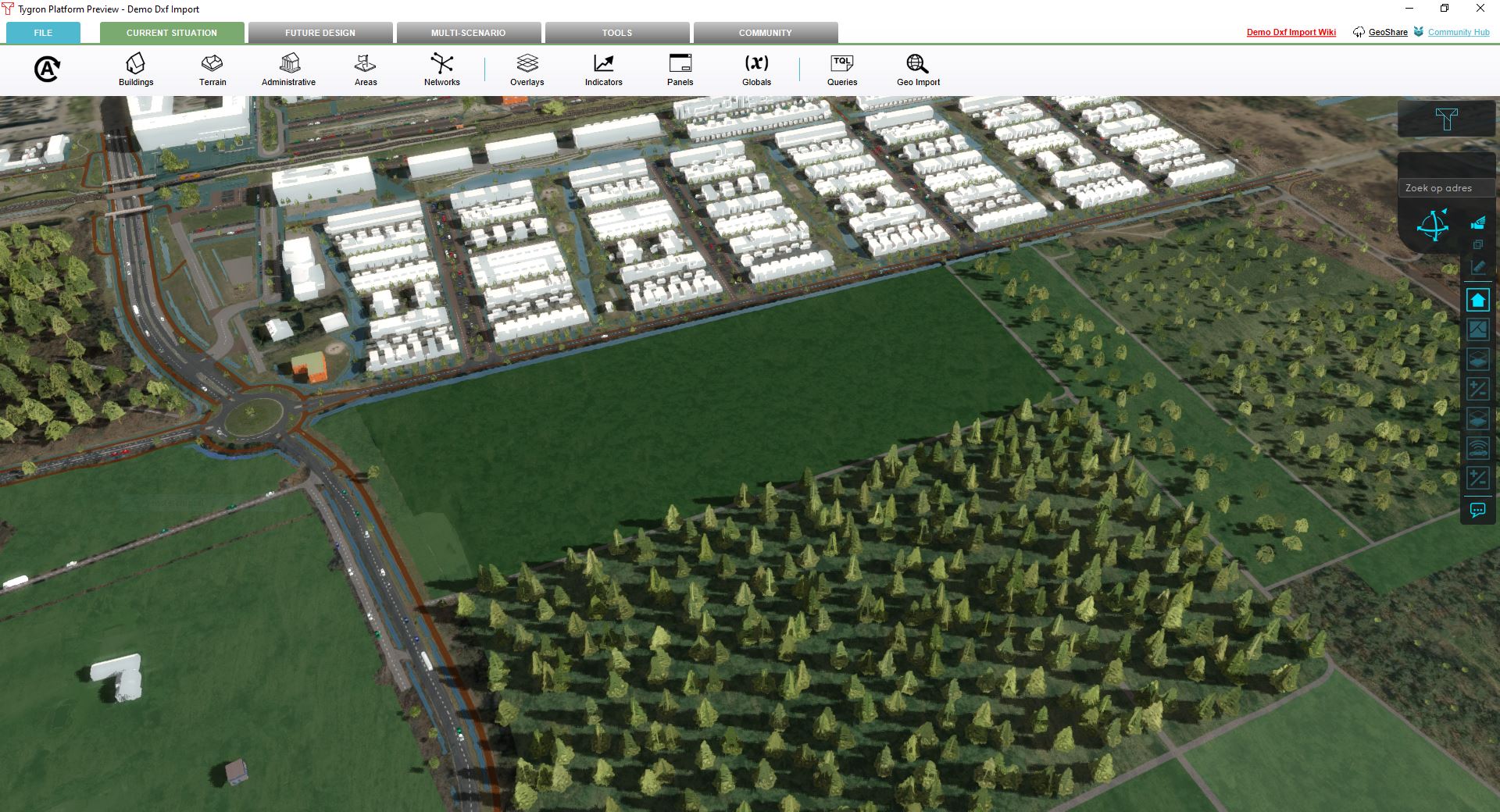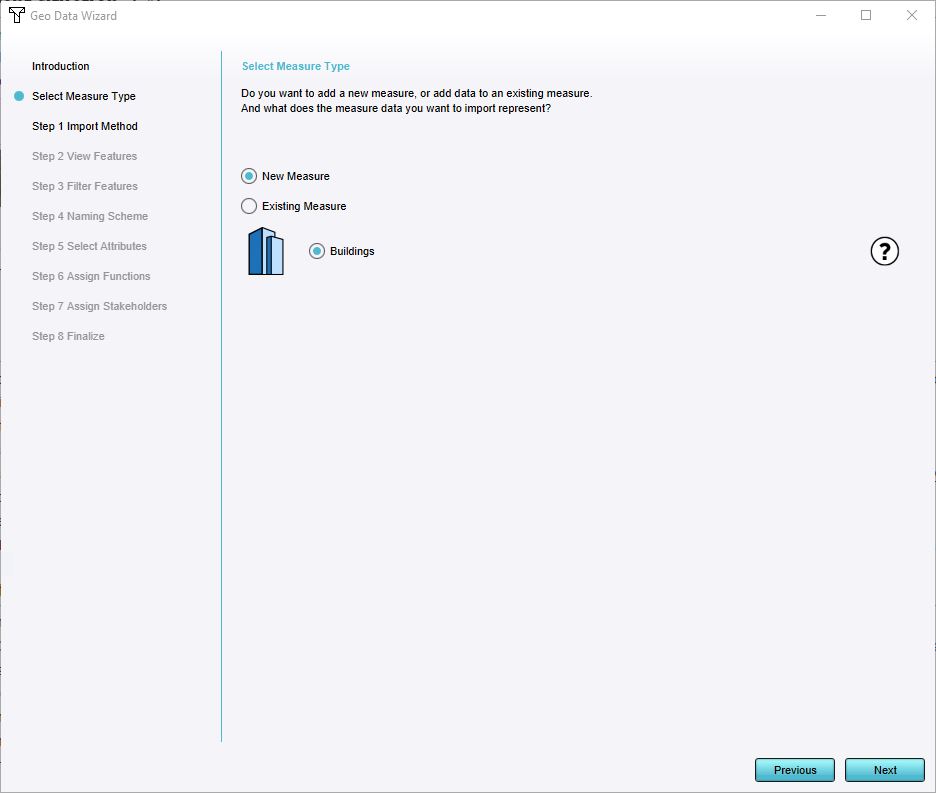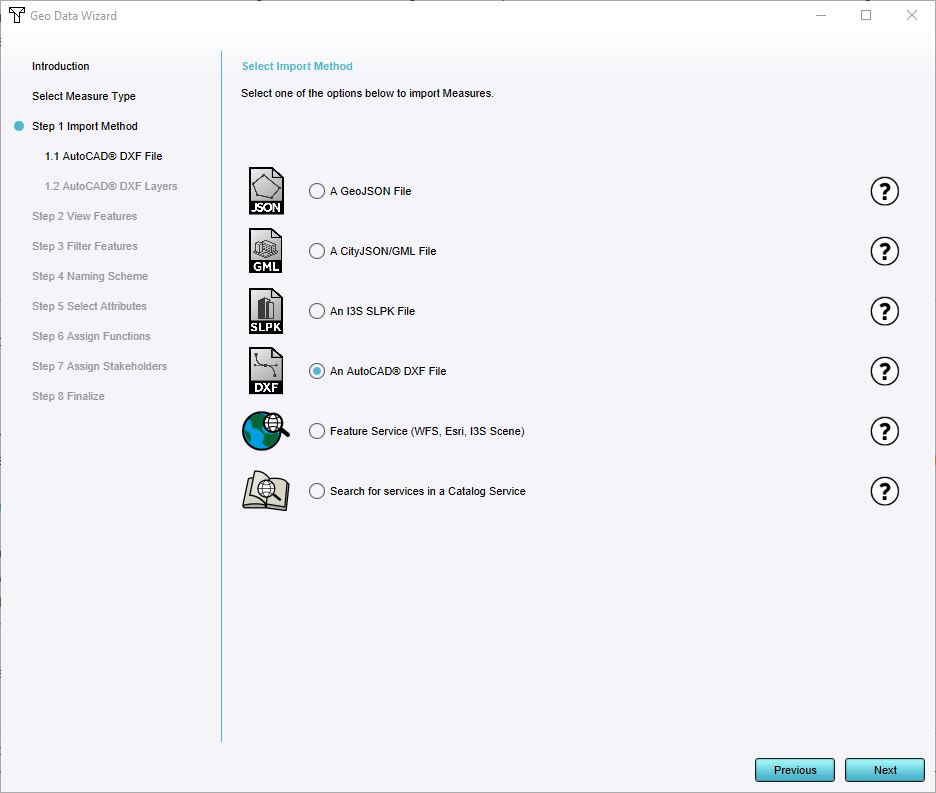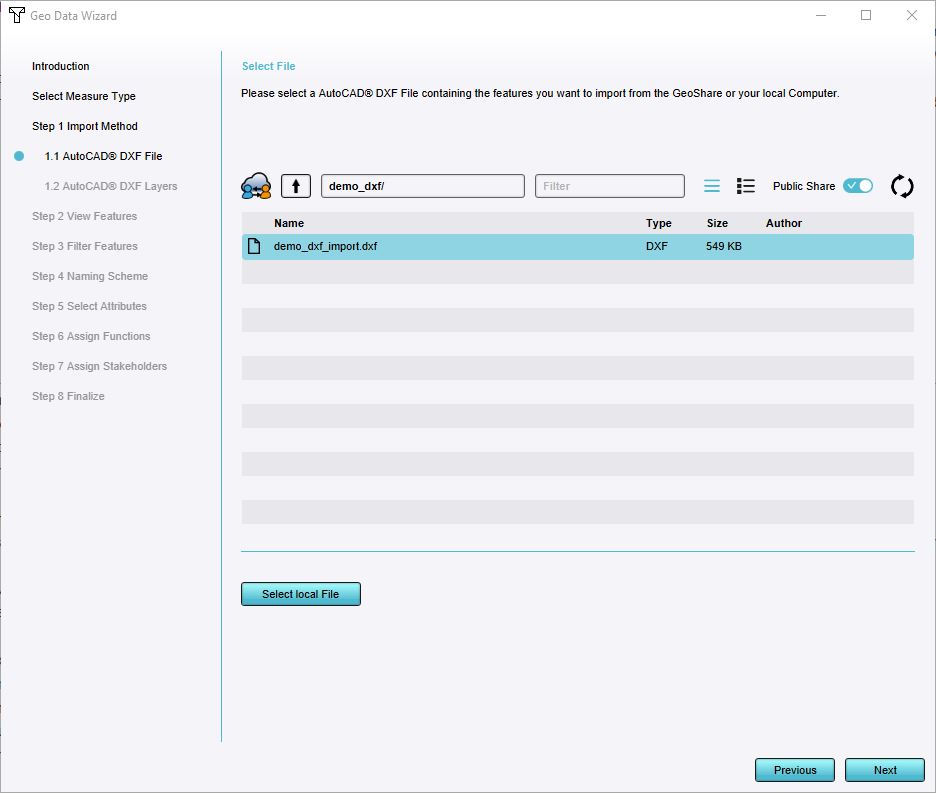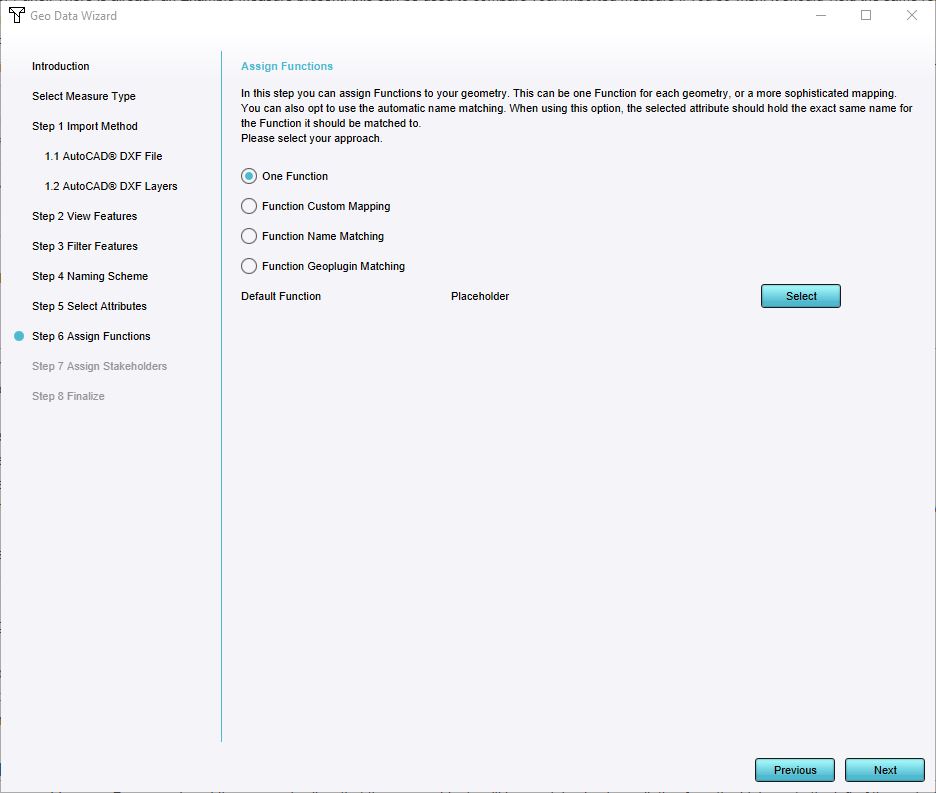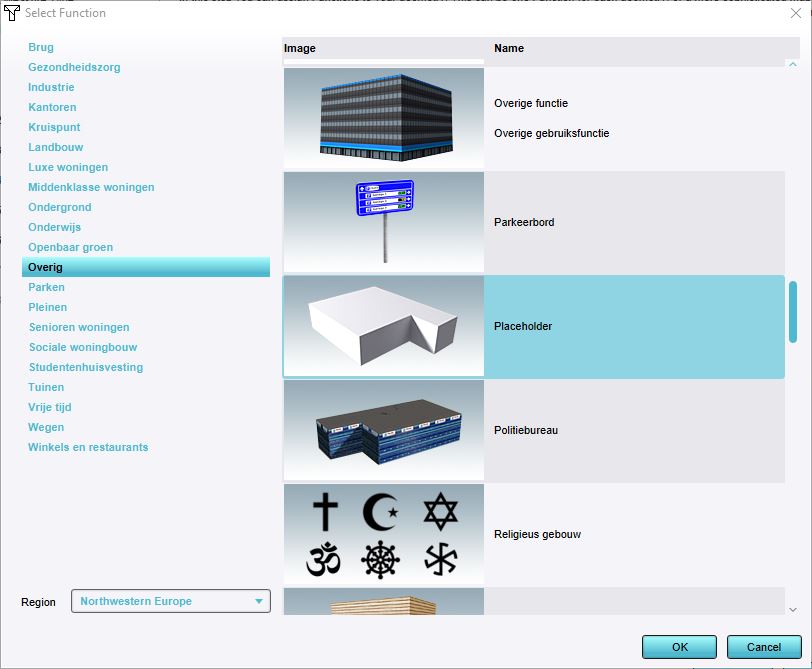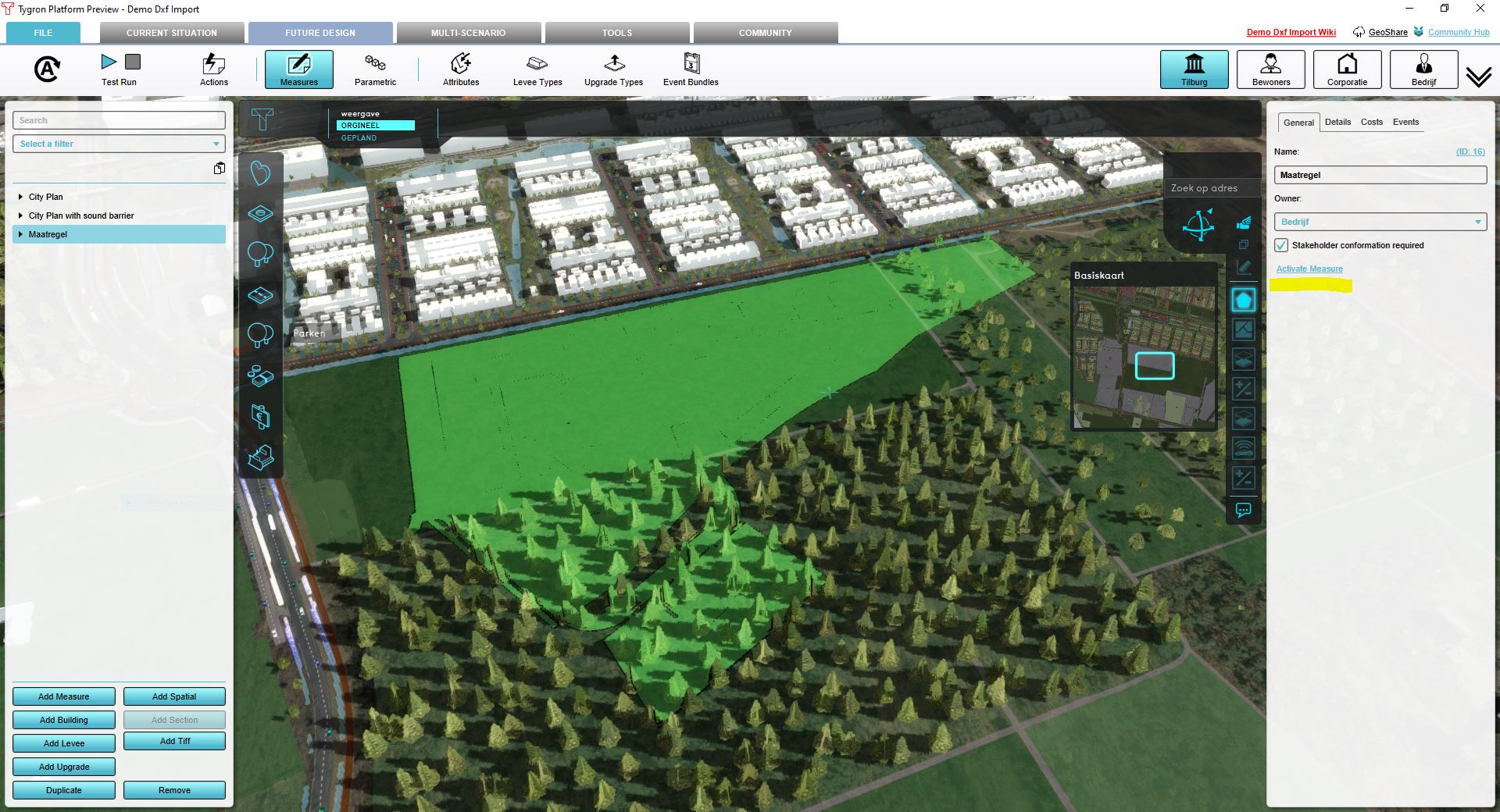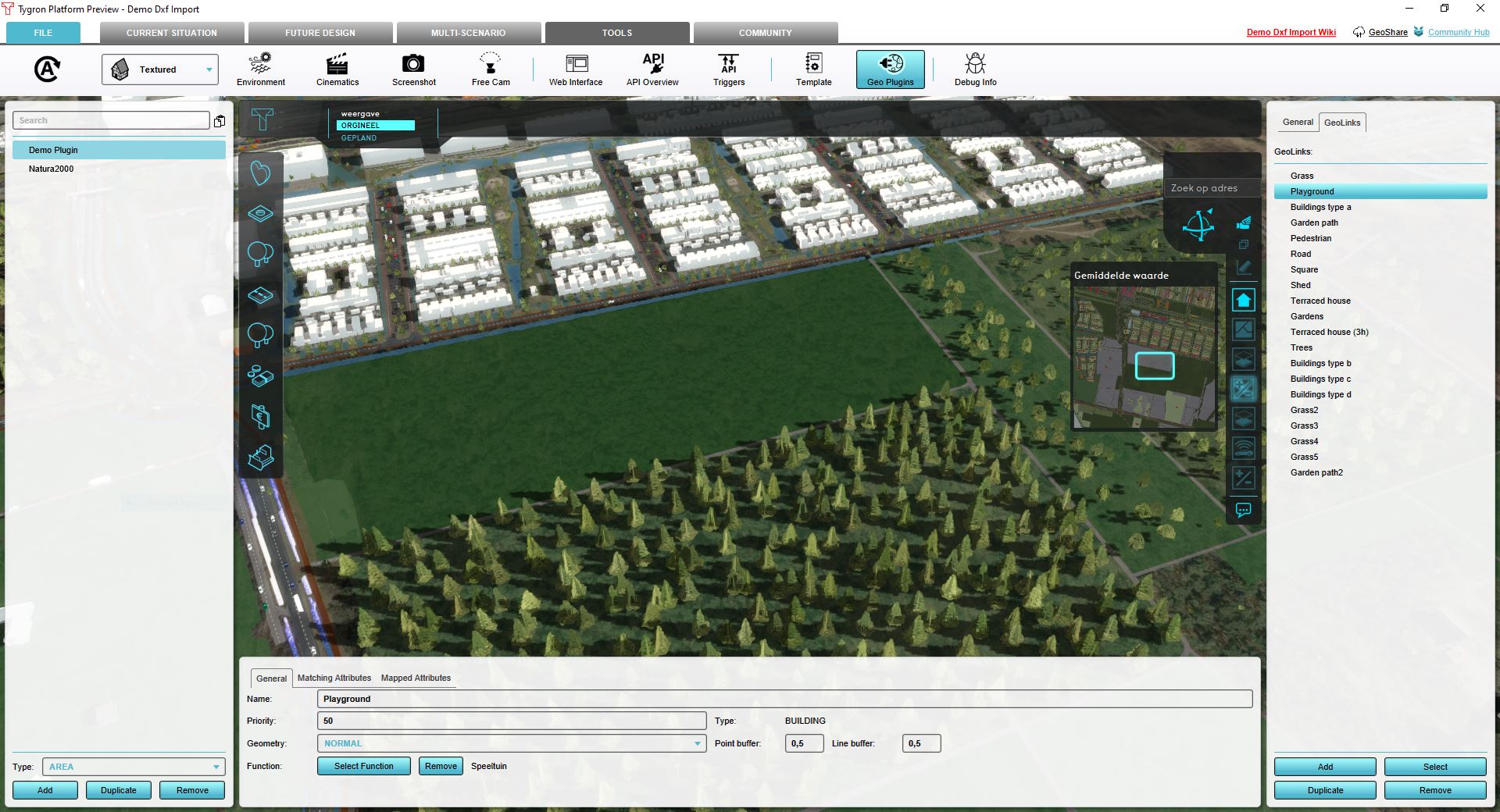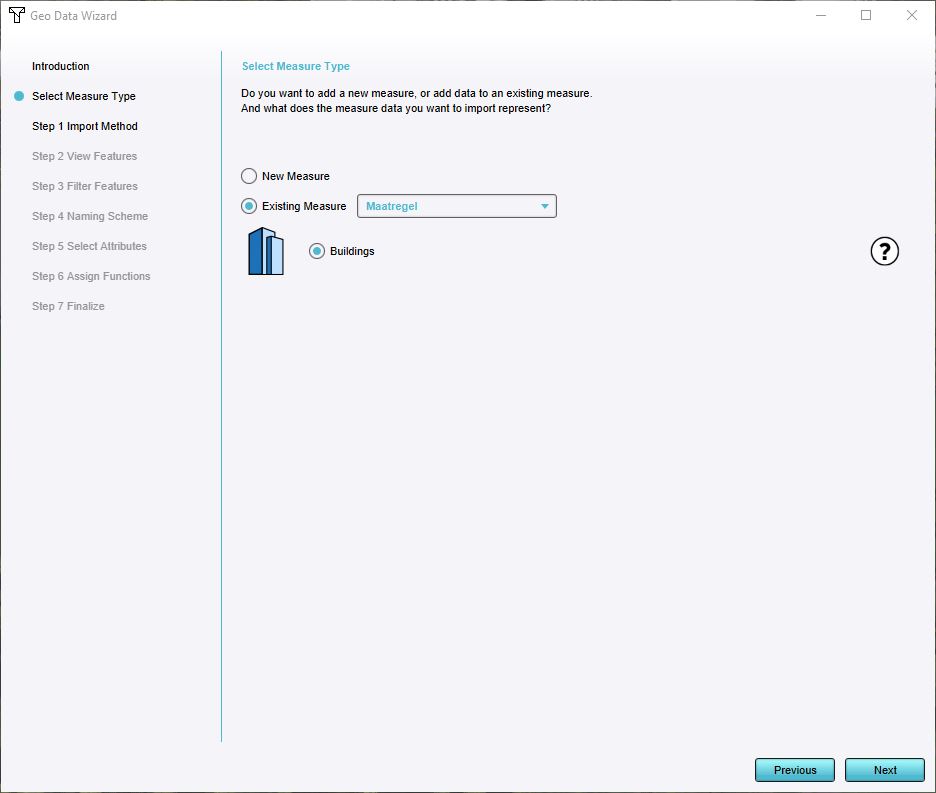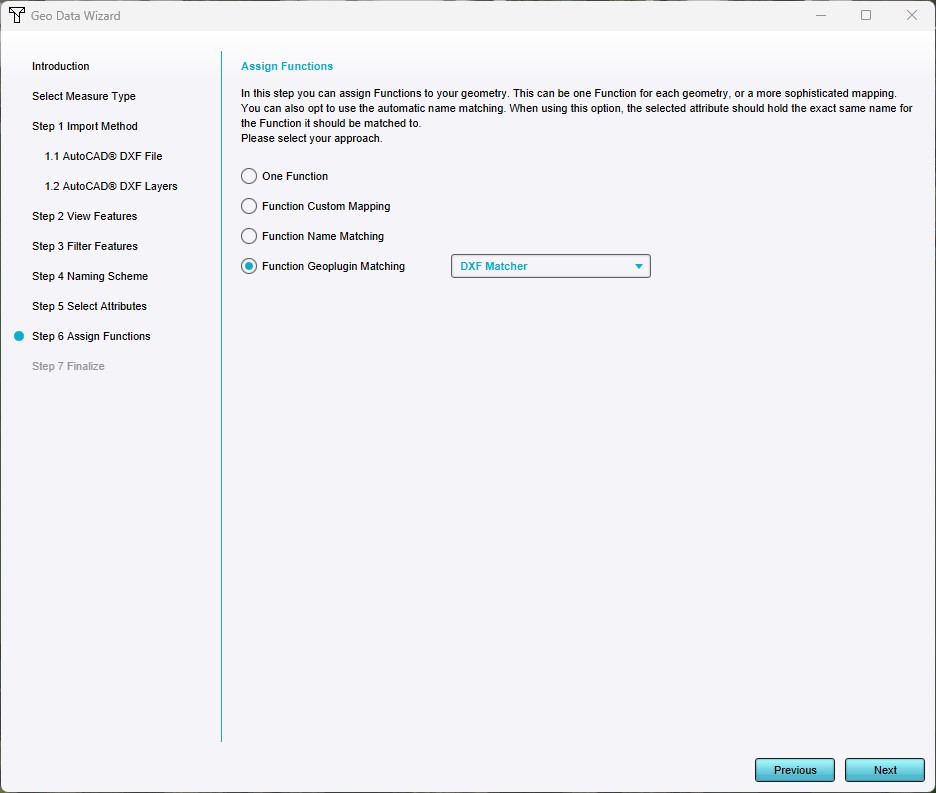Demo Dxf Import Project: Difference between revisions
No edit summary |
|||
| (36 intermediate revisions by 3 users not shown) | |||
| Line 3: | Line 3: | ||
| demographic=Urban planners, architects and consultants | | demographic=Urban planners, architects and consultants | ||
| showcases=how to import a DXF file into the project, how to add a Geotiff to a measure | | showcases=how to import a DXF file into the project, how to add a Geotiff to a measure | ||
| image=DXF_project. | | image=DXF_project.jpg | ||
| description= In this demo project | | description= In this demo project an architectural plan {{ref|urban plan}} is imported to a location in the Netherlands by means of an [[DXF]] file. This file is made in [[AutoCAD]], slightly adjusted for demo purposes and exported to DXF. | ||
}} | }} | ||
===About the project=== | ===About the project=== | ||
This project | This project contains a potential project development area where several architectural plans are situated. The project area partially consists of open land, a few waterway and a forest and is situated near [https://en.wikipedia.org/wiki/Tilburg Tilburg] in the Netherlands. The content of each architectural plan is stored in a [DXF] file were prepared beforehand. Each DXF file is imported as a [[measure]] and further enriched which [[Grid]]s and [[GeoTIFF]]s that adjust the [[Digital Terrain Model]] when applied. | ||
==Explore the current situation== | ==Explore the current situation== | ||
| Line 19: | Line 19: | ||
==Import DXF file== | ==Import DXF file== | ||
# First go to the [[How to import a DXF]] tutorial. Use the "Demo_DXF_import.dxf" from the DXF Import folder on the Public [[GeoShare]]. To access the Public [[GeoShare]] click on the top right link in the | # First go to the [[How to import a DXF]] tutorial. Use the "Demo_DXF_import.dxf" from the DXF Import folder on the Public [[GeoShare]]. To access the Public [[GeoShare]] click on the top right link in the [[Ribbon bar]]. | ||
# When prompted in the [[Geo Data Wizard]], choose import as measure and also as a new measure. We will therefore be designing a Future Design project. | # When prompted in the [[Geo Data Wizard]], choose import as [[measure]] and also as a new measure. We will therefore be designing a Future Design project. | ||
# When prompted for function mapping just use One function and pick "placeholder" as a function for now. All other steps can be left as default. | # When prompted for function mapping just use One function and pick "placeholder" as a [[function]] for now. All other steps can be left as default. | ||
# When the [[Geo Data Wizard]] has finished, go to the [[Future Design]] tab and click on the [[Measures]] button on the Ribbon | # When the [[Geo Data Wizard]] has finished, go to the [[Future Design]] tab and click on the [[Measures]] button on the [[Ribbon bar]]. | ||
# Notice a new Measure (Maatregel) has been created on the | # Notice a new Measure (Maatregel) has been created on the [[Left Panel]]. There are already Example Measures present, these can be used to compare your imported measure if you so wish. It should yield the same results. | ||
# Click on your imported measure and also expand it by clicking on the flag icon next to it. Notice that the Measure contains buildings. These are the buildings which were present in the DXF file and which were identified as building in the [[Geo Data Wizard]]. | # Click on your imported measure and also expand it by clicking on the flag icon next to it. Notice that the Measure contains buildings. These are the buildings which were present in the DXF file and which were identified as building in the [[Geo Data Wizard]]. | ||
# With the measure still highlighted go to the Right Editor Panel and click on Activate Measure. | # With the measure still highlighted go to the Right Editor Panel and click on Activate Measure. | ||
| Line 38: | Line 38: | ||
==Use Geo Plugin to map functions== | ==Use Geo Plugin to map functions== | ||
# In | # In this example we will use a [[Geo Plugin]] to automatically map features imported from a DXF file to [[Function]]s, which will be used to create [[Building]]s that in turn can be combined into a single [[Measure]]. | ||
# For this demo | # For this demo this Geo Plugin has already been created and configured. To learn how to make your own Geo Plugin just follow this how-to: [[How to create a Geo Plugin to import Buildings from a DXF]] | ||
# First stop the Test Run if it is still Running. This will deactivate the | # First [[Test Run#Stopping a Test run|stop the Test Run]] if it is still Running. This will deactivate any activated [[Measure]]s and allows you to edit the [[Current Situation]] of your project. | ||
# Go to the [[Tools]] tab on de | # Go to the [[Tools]] tab on de [[Ribbon bar]] and click on the Geo Plugin button. | ||
# On the Left | # On the [[Left Panel]] a list of existing Geo Plugins is shown. | ||
# Click on the Building Plugin entry and go to the Right Panel for its properties. | # Click on the Building Plugin entry and go to the [[Right Panel]] for its properties. | ||
# Go to the | # Go to the Geo Links Tab. A list of Geo Links is shown. Every link corresponds to a Tygron Function with a Layer or Block reference in AutoCAD. | ||
# Click on one of the | # Click on one of the [[Geo Link]]s. An attribute window appears at the bottom of the Editor Interface which shows all the correspondences made for each Link. we will not go into them right now. If you want to learn how to make your own just follow this [[How to create a Geo Plugin to import Buildings from a DXF|how-to]]. | ||
# It is sufficient to know for now that the Geo Plugin will match with the AutoCAD layers and the imported DXF will visualize correctly. | # It is sufficient to know for now that the Geo Plugin will match with the AutoCAD layers and the imported DXF will visualize correctly. | ||
# To correct the fact that in the section above the Measure appeared as just one building, we will now import the DXF file again but change some of the import settings so that it will use the | # To correct the fact that in the section above the Measure appeared as just one building, we will now import the DXF file again but change some of the import settings so that it will use the Geo Plugin. | ||
# So as before go to the Future Design Tab and click on Measures. Choose import Geo Data. This will open the Geo Data Wizard again. | # So as before go to the Future Design Tab and click on Measures. Choose import Geo Data. This will open the Geo Data Wizard again. | ||
# When prompted to Select Measure Type choose Existing Measure instead of New. We will be changing the Measure we previously imported only. Choose your Measure from the drop-down selection box. | # When prompted to Select Measure Type choose Existing Measure instead of New. We will be changing the Measure we previously imported only. Choose your Measure from the drop-down selection box. | ||
| Line 62: | Line 62: | ||
==Adding more elements to the Measure== | ==Adding more elements to the Measure== | ||
Sometimes there is a wish to show the impact of variations on a Measure. For example: adding a soundwall so that the new residents will have minimal noise pollution from a nearby highway. | |||
To achieve this, we will be adding a Spatial based on a [[GeoTiff]] to the existing Measure. This means that when the Measure is activated as normal a new soundwall has been created next to it. This illustrates the diversity of data that Tygron can import to combine multiple sources for a new result. | |||
# Click on the Measure that you have created previously. | # Click on the Measure that you have created previously. | ||
# From the lower menu choose the "Add Tiff" option. This will create a new Tiff entry with the name TiffSpatial 1 as part of your Measure. | # From the lower menu choose the "Add Tiff" option. This will create a new Tiff entry with the name TiffSpatial 1 as part of your Measure. | ||
# On the Right Editor Panel choose "Add" to fill the entry with a GeoTiff. A selection window appears. Click on the "Add GeoShare File" from the lower left link in the window. Choose "demo_dxf.tiff" from the demo_dxf folder on the GeoShare. You can always choose a file from your local folder on you PC but for now we have prepared the files on the GeoShare. | # On the Right Editor Panel choose "Add" to fill the entry with a GeoTiff. A selection window appears. Click on the "Add GeoShare File" from the lower left link in the window. Choose "demo_dxf.tiff" from the demo_dxf folder on the GeoShare. You can always choose a file from your local folder on you PC but for now we have prepared the files on the GeoShare. | ||
# The GeoTiff's name appears on the panel and you are now ready to Activate the Measure again. | # The GeoTiff's name appears on the panel and you are now ready to Activate the Measure again. | ||
# Notice that a soundwall has been raised on the left side below the roundabout. This soundwall will have direct impact when calculating a noise pollution overlay for example. You can | # Notice that a soundwall has been raised on the left side below the roundabout. This soundwall will have direct impact when calculating a noise pollution overlay for example. You can visualize this by choosing the Traffic Noise Overlay on the right and switching form 'original' to 'planned' situation in the top left of your project. | ||
# You have now | # You have now successfully added a new Measure based on DXF data and enriched the Measure with additional Spatial data. You are now ready to analyse your project on different Themes such as Noise pollution. | ||
==Explore further== | ==Explore further== | ||
| Line 77: | Line 77: | ||
|howtos= | |howtos= | ||
*[[How to import a DXF]] | *[[How to import a DXF]] | ||
*[[How to | *[[How to predefine the DXF geo-location in AutoCAD]] | ||
*[[How to set the unit of measurement for a DXF]] | *[[How to set the unit of measurement for a DXF]] | ||
*[[How to create a Geo Plugin to import Buildings from a DXF]] | *[[How to create a Geo Plugin to import Buildings from a DXF]] | ||
*[[How to deal with a long processing DXF import]] | *[[How to deal with a long processing DXF import]] | ||
*[[ | *[[How to add a GeoTIFF to a measure]] | ||
*[[How to export a DXF]] | *[[How to export a DXF]] | ||
|videos= | |videos= | ||
<youtube>M0ngp0FwAG4</youtube> | |||
| references=<references> | | references=<references> | ||
{{ref|urban plan | {{ref|urban plan | ||
|name=urban plan | |name=original urban plan | ||
|author= | |author= | ||
|page= | |page= | ||
Latest revision as of 09:41, 8 October 2025
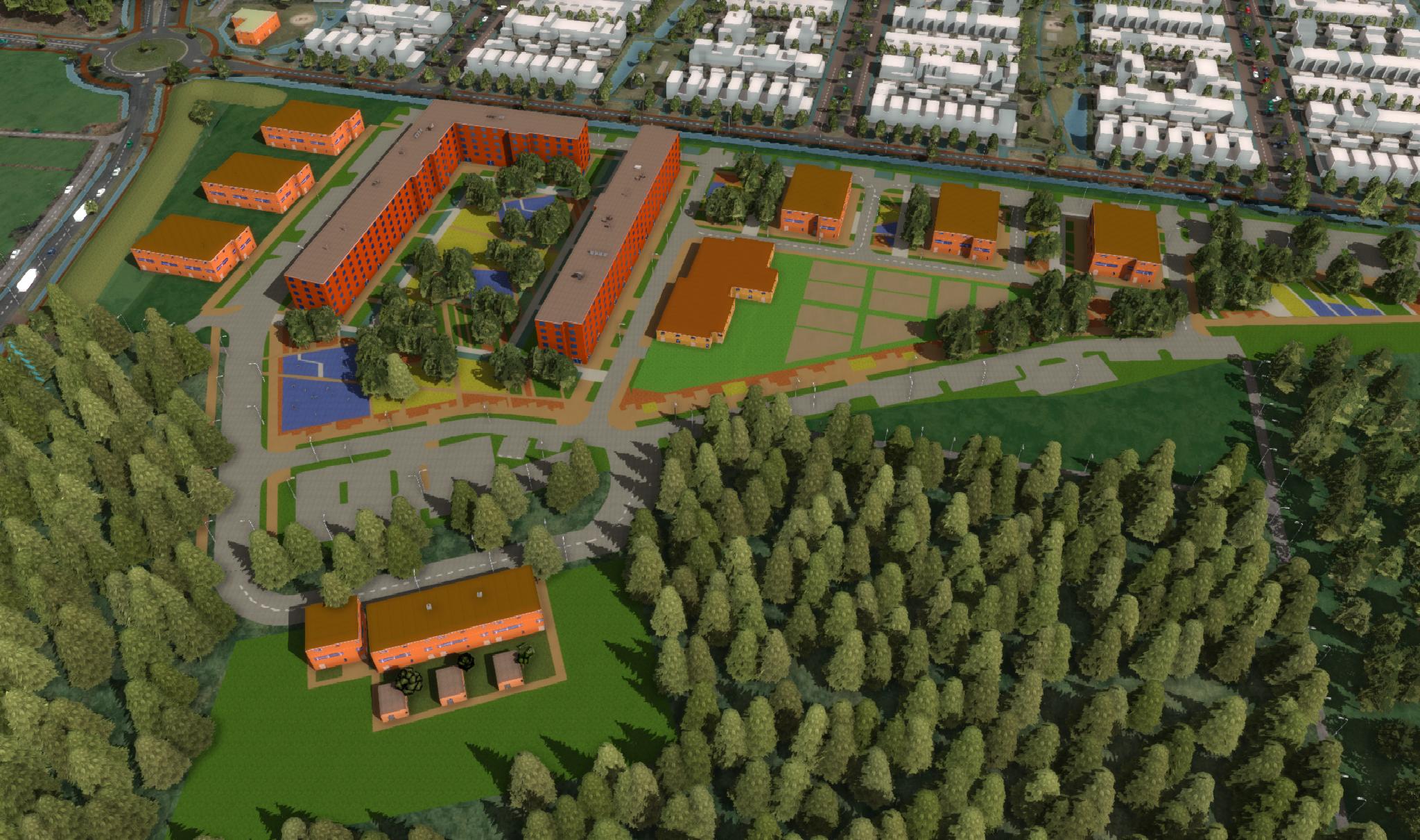
The Demo DXF import project is available for all users and can be found in the main menu under Edit projects. This project does not count towards your license.
This project is intended for Urban planners, architects and consultants.
This project showcases how to import a DXF file into the project, how to add a Geotiff to a measure.
In this demo project an architectural plan [1] is imported to a location in the Netherlands by means of an DXF file. This file is made in AutoCAD, slightly adjusted for demo purposes and exported to DXF.
About the project
This project contains a potential project development area where several architectural plans are situated. The project area partially consists of open land, a few waterway and a forest and is situated near Tilburg in the Netherlands. The content of each architectural plan is stored in a [DXF] file were prepared beforehand. Each DXF file is imported as a measure and further enriched which Grids and GeoTIFFs that adjust the Digital Terrain Model when applied.
Explore the current situation
- Click anywhere in the 3D Visualization, and use the arrow keys on your keyboard to move around. You can also drag the camera around by left-clicking (and holding the right mouse button down) in the 3D Visualization and dragging the camera around. Use the scroll wheel to zoom in- and out. By right-clicking and dragging you can rotate the camera.
- Zoom out and observe the current situation. You can see a big empty plot of land to the right of the roundabout. This is the area where we will load a new plan.
-
The Area where the new plan will be imported
Import DXF file
- First go to the How to import a DXF tutorial. Use the "Demo_DXF_import.dxf" from the DXF Import folder on the Public GeoShare. To access the Public GeoShare click on the top right link in the Ribbon bar.
- When prompted in the Geo Data Wizard, choose import as measure and also as a new measure. We will therefore be designing a Future Design project.
- When prompted for function mapping just use One function and pick "placeholder" as a function for now. All other steps can be left as default.
- When the Geo Data Wizard has finished, go to the Future Design tab and click on the Measures button on the Ribbon bar.
- Notice a new Measure (Maatregel) has been created on the Left Panel. There are already Example Measures present, these can be used to compare your imported measure if you so wish. It should yield the same results.
- Click on your imported measure and also expand it by clicking on the flag icon next to it. Notice that the Measure contains buildings. These are the buildings which were present in the DXF file and which were identified as building in the Geo Data Wizard.
- With the measure still highlighted go to the Right Editor Panel and click on Activate Measure.
- The Test Run will start and the new plan will appear. Notice that the plan is visualized as one big building. We will fix this in the next section. For now you have created a new measure which was imported from a DXF file.
-
Choose New Measure
-
Choose Import AutoCAD DXF file
-
Choose DXF file from Public Share
-
Choose One Function
-
Choose Placeholder function
-
Activate Measure
Use Geo Plugin to map functions
- In this example we will use a Geo Plugin to automatically map features imported from a DXF file to Functions, which will be used to create Buildings that in turn can be combined into a single Measure.
- For this demo this Geo Plugin has already been created and configured. To learn how to make your own Geo Plugin just follow this how-to: How to create a Geo Plugin to import Buildings from a DXF
- First stop the Test Run if it is still Running. This will deactivate any activated Measures and allows you to edit the Current Situation of your project.
- Go to the Tools tab on de Ribbon bar and click on the Geo Plugin button.
- On the Left Panel a list of existing Geo Plugins is shown.
- Click on the Building Plugin entry and go to the Right Panel for its properties.
- Go to the Geo Links Tab. A list of Geo Links is shown. Every link corresponds to a Tygron Function with a Layer or Block reference in AutoCAD.
- Click on one of the Geo Links. An attribute window appears at the bottom of the Editor Interface which shows all the correspondences made for each Link. we will not go into them right now. If you want to learn how to make your own just follow this how-to.
- It is sufficient to know for now that the Geo Plugin will match with the AutoCAD layers and the imported DXF will visualize correctly.
- To correct the fact that in the section above the Measure appeared as just one building, we will now import the DXF file again but change some of the import settings so that it will use the Geo Plugin.
- So as before go to the Future Design Tab and click on Measures. Choose import Geo Data. This will open the Geo Data Wizard again.
- When prompted to Select Measure Type choose Existing Measure instead of New. We will be changing the Measure we previously imported only. Choose your Measure from the drop-down selection box.
- Click Next and keep all settings default except when the Wizard prompts you to Assign Functions. Previously we used the One Function option. This caused the Measure to appear as just one building.
- Choose the Function Geo Plugin Matching option instead. Choose the Demo Plugin "DXF Matcher" from the Drop-down list. Click Next and then Click Finish
- The Measure has been updated to use The Geo Plugin to apply different Functions to different elements in the DXF file.
- Activate the Measure as before. Notice that the plan is imported correctly now. If you want to compare you can always activate the Example Measure to check for any errors.
-
Explore current Building Plugin
-
Choose Existing Measure
-
Assign Functions
Adding more elements to the Measure
Sometimes there is a wish to show the impact of variations on a Measure. For example: adding a soundwall so that the new residents will have minimal noise pollution from a nearby highway. To achieve this, we will be adding a Spatial based on a GeoTiff to the existing Measure. This means that when the Measure is activated as normal a new soundwall has been created next to it. This illustrates the diversity of data that Tygron can import to combine multiple sources for a new result.
- Click on the Measure that you have created previously.
- From the lower menu choose the "Add Tiff" option. This will create a new Tiff entry with the name TiffSpatial 1 as part of your Measure.
- On the Right Editor Panel choose "Add" to fill the entry with a GeoTiff. A selection window appears. Click on the "Add GeoShare File" from the lower left link in the window. Choose "demo_dxf.tiff" from the demo_dxf folder on the GeoShare. You can always choose a file from your local folder on you PC but for now we have prepared the files on the GeoShare.
- The GeoTiff's name appears on the panel and you are now ready to Activate the Measure again.
- Notice that a soundwall has been raised on the left side below the roundabout. This soundwall will have direct impact when calculating a noise pollution overlay for example. You can visualize this by choosing the Traffic Noise Overlay on the right and switching form 'original' to 'planned' situation in the top left of your project.
- You have now successfully added a new Measure based on DXF data and enriched the Measure with additional Spatial data. You are now ready to analyse your project on different Themes such as Noise pollution.
Explore further
Go to the Main Page and learn more about the different Overlay calculations that can be used on this project. You can find a selection of Overlays under the Calculations Header.
How-to's
- How to import a DXF
- How to predefine the DXF geo-location in AutoCAD
- How to set the unit of measurement for a DXF
- How to create a Geo Plugin to import Buildings from a DXF
- How to deal with a long processing DXF import
- How to add a GeoTIFF to a measure
- How to export a DXF
Videos
References
- ↑ original urban plan ∙ Found at: https://dwgmodels.com/642-urban-design.html ∙ (last visited: 20-01-2023)
